What to do if the Maytag Freezer compressor has no pressure?
- BBenjamin BaldwinAug 2, 2025
If the Maytag Freezer's compressor shows no evidence of internal pressure when cutting the line or pulling the plugs, it should be returned for replacement.
What to do if the Maytag Freezer compressor has no pressure?
If the Maytag Freezer's compressor shows no evidence of internal pressure when cutting the line or pulling the plugs, it should be returned for replacement.
Critical notices for technicians and users regarding safety and service.
Lists phone numbers and websites for customer service and support centers.
Explains the meaning of various safety symbols and warning labels used in the manual.
Explains the coding system used to identify Amana and Maytag freezer models.
Steps for removing protective packaging and preparing the freezer for installation.
Provides general advice and requirements for installing the freezer unit.
Guidance on selecting an appropriate location for optimal freezer performance.
Details on proper electrical hookup, grounding, and voltage requirements.
Step-by-step instructions for attaching the freezer door handle.
Procedures for ensuring the freezer is correctly leveled for proper operation.
Essential tests and checks to perform after the freezer has been installed.
Specifics on electrical supply, grounding, and safety precautions.
Information on locating and recording model and serial numbers for service.
Guidelines for safely disposing of an old freezer to prevent hazards.
Guidance on adjusting the temperature control for optimal operation.
Detailed explanation of the temperature control dial settings and adjustments.
Introduces various features of the freezer, including door lock and racks.
Instructions on how to use and secure the freezer's door lock.
How to install and utilize the reversible rack for flexible storage.
Recommendations for proper food wrapping and recommended storage times.
Basic instructions for cleaning the freezer interior and exterior surfaces.
Method for effectively removing sticky residues from surfaces.
How to clean and maintain freezer door gaskets for a proper seal.
Steps to eliminate unpleasant odors from inside the freezer.
Step-by-step guide for manually defrosting the freezer.
Instructions for safely replacing the freezer's internal light bulb.
Advice for operating the freezer efficiently to reduce energy consumption.
How to prepare the freezer for extended periods of non-use.
Identifies and explains the typical sounds the freezer may produce.
Guidance on diagnosing and resolving common freezer problems before calling service.
Visual representation of normal operating sounds and their sources within the freezer.
Methodologies for testing the refrigeration system's components and performance.
Procedure for testing the functionality and integrity of the main condenser.
Safety precautions and methods for detecting refrigerant leaks in the system.
Information on safe electrical handling and grounding practices.
Steps for testing the electrical integrity of the compressor.
How to perform a direct electrical test on the compressor.
Explains the overload protector and details its testing procedure.
Instructions on how to test the compressor's start capacitor using a meter.
Procedure for testing the Positive Temperature Coefficient (PTC) relay.
Steps to test the freezer's interior light and its associated switch.
How to verify the correct operation of the freezer's temperature control.
Procedures for testing the temperature control's cut-in and cut-out points.
Details on how the defrost timer functions to initiate defrost cycles.
Step-by-step guide to test the defrost timer's continuity and function.
Procedures for testing the defrost heater and its safety thermostat.
How to test the freezer fan motor for proper operation.
Addresses causes and corrections for frost accumulation on the evaporator coil.
Troubleshoots high freezer temperatures and external sweating.
Diagnoses issues when the compressor fails to start and the light is off.
Addresses issues like short cycling and the freezer not freezing adequately.
Solutions for problems related to water drainage during defrost cycles.
Step-by-step instructions for replacing the refrigerant drier filter.
Detailed guide for removing and installing a replacement compressor.
Procedure for replacing the heat exchanger in refrigerated shelf freezer models.
Procedure for replacing the heat exchanger in no-defrosting freezer models.
How to remove and replace steel shelves in refrigerated shelf models.
Instructions for removing and replacing the freezer coil in no-defrosting units.
Steps for removing and installing a new interior light switch.
Guide for replacing the freezer's temperature control assembly.
Instructions for replacing the defrost heater component.
Procedure for removing and installing a replacement freezer fan motor.
Overview of the various parts that make up the freezer's cabinet door assembly.
Steps for safely removing and reinstalling the freezer door.
Instructions for replacing the inner door liner and its gasket.
How to remove and install the freezer door handle and insert.
Explanation of the door lock mechanism, its operation, and common issues.
Detailed steps for disassembling and removing the door lock.
Procedures for aligning the freezer door for proper closure and seal.
Methods to check door gasket seal effectiveness and improve it.
How to adjust door hinges to correct sagging or misalignment.
Description of the freezer's cabinet structure, liner, and drain system components.
Basic principles of how the freezer's refrigeration system functions.
Common causes and troubleshooting steps for compressor failure.
Problems related to incorrect refrigerant levels and their diagnosis.
Identifying and resolving blockages within the low-side refrigerant tubing.
Details on how pressure unloading occurs within the refrigeration system.
Understanding and troubleshooting overload conditions during freezer operation.
Procedures for measuring and interpreting system pressures for diagnostics.
Methods for conducting functional tests on the freezer's operation.
Practical advice for servicing and customer usage recommendations.
Information on compressor on/off cycles and normal operating noise.
Diagnosing and addressing potential voids in the freezer's insulation.
Common customer complaints and diagnostic steps for refrigeration issues.
Methods for finding and repairing refrigerant leaks, including internal types.
Detailed steps for evacuating and charging the refrigeration system.
Technical data and properties of HFC134a refrigerant compared to CFC12.
Critical safety precautions for working with HFC134a refrigerant.
Lists specialized tools and equipment required for servicing HFC134a systems.
Step-by-step guide for replacing the system's drier filter.
Instructions for installing a new HFC134a compatible compressor.
Correct refrigerant charge amounts and procedures for leak testing.
Typical setup and detailed steps for system evacuation and charging.
Process for removing moisture from the sealed system to prevent acid formation.
Safety measures and techniques for brazing refrigeration system joints.
Essential safety guidelines for handling refrigerants to prevent injury.
Importance of preventing atmospheric contamination of refrigeration lines.
Guidance on using line piercing valves for diagnosis and their limitations.
How to adjust the temperature control for variations in altitude.
Description of the outer steel shell and its construction features.
Details on the interior liner and how components are attached.
Explanation of the defrost water drain system and its maintenance.
Electrical schematic showing the wiring for manual defrost freezer models.
Electrical schematic illustrating the wiring for frost-free freezer models.
Critical notices for technicians and users regarding safety and service.
Lists phone numbers and websites for customer service and support centers.
Explains the meaning of various safety symbols and warning labels used in the manual.
Explains the coding system used to identify Amana and Maytag freezer models.
Steps for removing protective packaging and preparing the freezer for installation.
Provides general advice and requirements for installing the freezer unit.
Guidance on selecting an appropriate location for optimal freezer performance.
Details on proper electrical hookup, grounding, and voltage requirements.
Step-by-step instructions for attaching the freezer door handle.
Procedures for ensuring the freezer is correctly leveled for proper operation.
Essential tests and checks to perform after the freezer has been installed.
Specifics on electrical supply, grounding, and safety precautions.
Information on locating and recording model and serial numbers for service.
Guidelines for safely disposing of an old freezer to prevent hazards.
Guidance on adjusting the temperature control for optimal operation.
Detailed explanation of the temperature control dial settings and adjustments.
Introduces various features of the freezer, including door lock and racks.
Instructions on how to use and secure the freezer's door lock.
How to install and utilize the reversible rack for flexible storage.
Recommendations for proper food wrapping and recommended storage times.
Basic instructions for cleaning the freezer interior and exterior surfaces.
Method for effectively removing sticky residues from surfaces.
How to clean and maintain freezer door gaskets for a proper seal.
Steps to eliminate unpleasant odors from inside the freezer.
Step-by-step guide for manually defrosting the freezer.
Instructions for safely replacing the freezer's internal light bulb.
Advice for operating the freezer efficiently to reduce energy consumption.
How to prepare the freezer for extended periods of non-use.
Identifies and explains the typical sounds the freezer may produce.
Guidance on diagnosing and resolving common freezer problems before calling service.
Visual representation of normal operating sounds and their sources within the freezer.
Methodologies for testing the refrigeration system's components and performance.
Procedure for testing the functionality and integrity of the main condenser.
Safety precautions and methods for detecting refrigerant leaks in the system.
Information on safe electrical handling and grounding practices.
Steps for testing the electrical integrity of the compressor.
How to perform a direct electrical test on the compressor.
Explains the overload protector and details its testing procedure.
Instructions on how to test the compressor's start capacitor using a meter.
Procedure for testing the Positive Temperature Coefficient (PTC) relay.
Steps to test the freezer's interior light and its associated switch.
How to verify the correct operation of the freezer's temperature control.
Procedures for testing the temperature control's cut-in and cut-out points.
Details on how the defrost timer functions to initiate defrost cycles.
Step-by-step guide to test the defrost timer's continuity and function.
Procedures for testing the defrost heater and its safety thermostat.
How to test the freezer fan motor for proper operation.
Addresses causes and corrections for frost accumulation on the evaporator coil.
Troubleshoots high freezer temperatures and external sweating.
Diagnoses issues when the compressor fails to start and the light is off.
Addresses issues like short cycling and the freezer not freezing adequately.
Solutions for problems related to water drainage during defrost cycles.
Step-by-step instructions for replacing the refrigerant drier filter.
Detailed guide for removing and installing a replacement compressor.
Procedure for replacing the heat exchanger in refrigerated shelf freezer models.
Procedure for replacing the heat exchanger in no-defrosting freezer models.
How to remove and replace steel shelves in refrigerated shelf models.
Instructions for removing and replacing the freezer coil in no-defrosting units.
Steps for removing and installing a new interior light switch.
Guide for replacing the freezer's temperature control assembly.
Instructions for replacing the defrost heater component.
Procedure for removing and installing a replacement freezer fan motor.
Overview of the various parts that make up the freezer's cabinet door assembly.
Steps for safely removing and reinstalling the freezer door.
Instructions for replacing the inner door liner and its gasket.
How to remove and install the freezer door handle and insert.
Explanation of the door lock mechanism, its operation, and common issues.
Detailed steps for disassembling and removing the door lock.
Procedures for aligning the freezer door for proper closure and seal.
Methods to check door gasket seal effectiveness and improve it.
How to adjust door hinges to correct sagging or misalignment.
Description of the freezer's cabinet structure, liner, and drain system components.
Basic principles of how the freezer's refrigeration system functions.
Common causes and troubleshooting steps for compressor failure.
Problems related to incorrect refrigerant levels and their diagnosis.
Identifying and resolving blockages within the low-side refrigerant tubing.
Details on how pressure unloading occurs within the refrigeration system.
Understanding and troubleshooting overload conditions during freezer operation.
Procedures for measuring and interpreting system pressures for diagnostics.
Methods for conducting functional tests on the freezer's operation.
Practical advice for servicing and customer usage recommendations.
Information on compressor on/off cycles and normal operating noise.
Diagnosing and addressing potential voids in the freezer's insulation.
Common customer complaints and diagnostic steps for refrigeration issues.
Methods for finding and repairing refrigerant leaks, including internal types.
Detailed steps for evacuating and charging the refrigeration system.
Technical data and properties of HFC134a refrigerant compared to CFC12.
Critical safety precautions for working with HFC134a refrigerant.
Lists specialized tools and equipment required for servicing HFC134a systems.
Step-by-step guide for replacing the system's drier filter.
Instructions for installing a new HFC134a compatible compressor.
Correct refrigerant charge amounts and procedures for leak testing.
Typical setup and detailed steps for system evacuation and charging.
Process for removing moisture from the sealed system to prevent acid formation.
Safety measures and techniques for brazing refrigeration system joints.
Essential safety guidelines for handling refrigerants to prevent injury.
Importance of preventing atmospheric contamination of refrigeration lines.
Guidance on using line piercing valves for diagnosis and their limitations.
How to adjust the temperature control for variations in altitude.
Description of the outer steel shell and its construction features.
Details on the interior liner and how components are attached.
Explanation of the defrost water drain system and its maintenance.
Electrical schematic showing the wiring for manual defrost freezer models.
Electrical schematic illustrating the wiring for frost-free freezer models.
| Brand | Maytag |
|---|---|
| Model Number | MQU2057AEW |
| Product Type | Freezer |
| Color | White |
| Defrost Type | Frost-free |
| Energy Star Certified | Yes |
| Installation Type | Freestanding |
| Door Swing | Reversible |
| Temperature Control | Electronic |
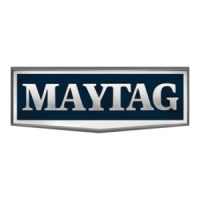

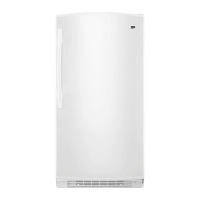
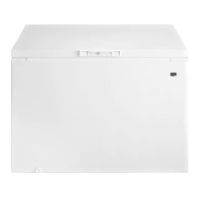

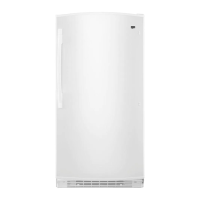
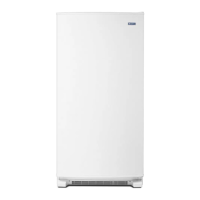
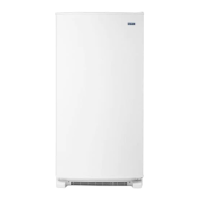

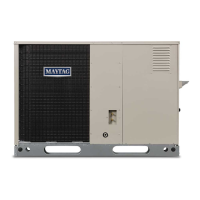
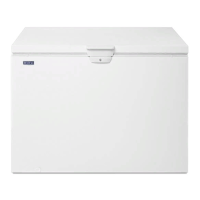

